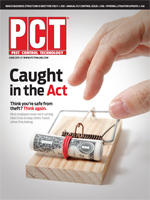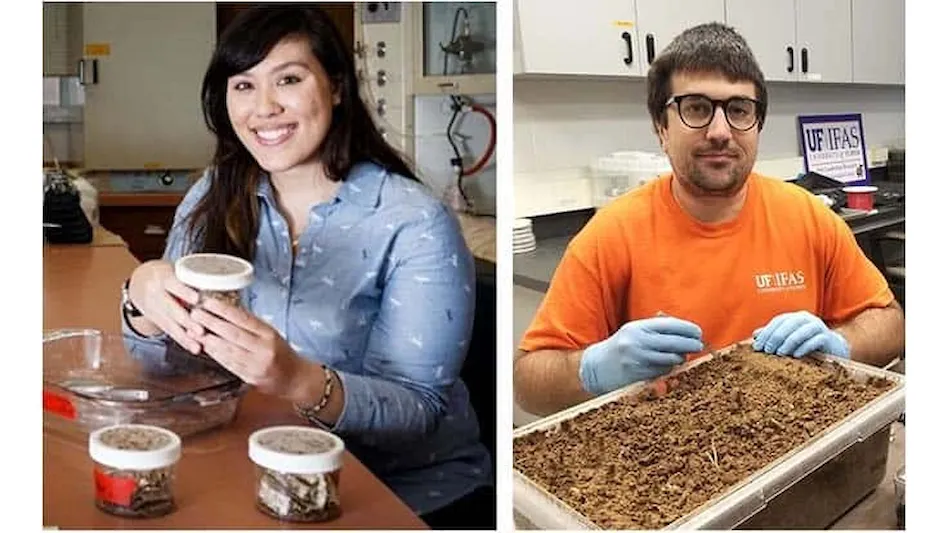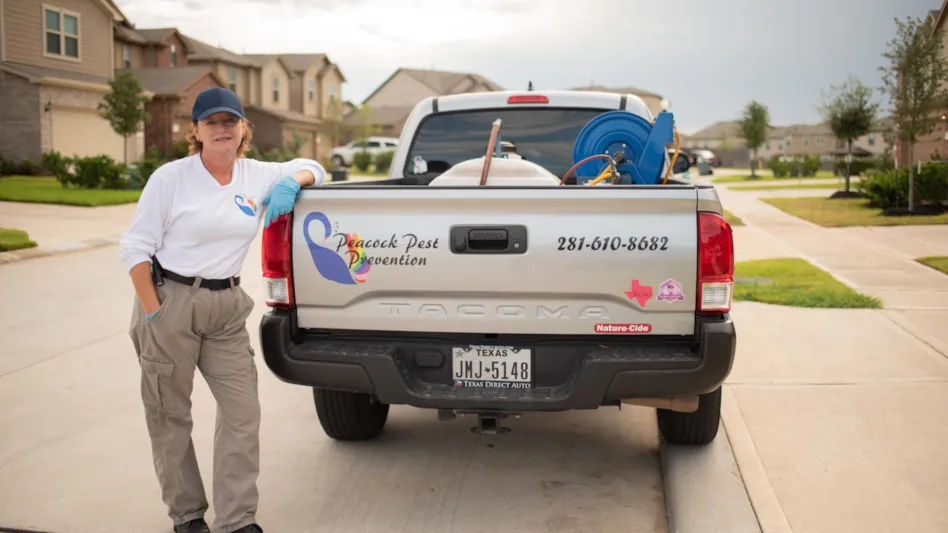Fleas are small, wingless insects that feed on the blood of animals and people. Many flea problems are caused by the cat flea, Ctenocephalides felis. This flea feeds on cats, dogs and wildlife. Other kinds of fleas, such as the dog flea, human flea and rat flea, are less common on pets and in homes. Fortunately, fleas need not be a serious problem because there are many effective treatments.
IDENTIFYING THE PROBLEM. Adult cat fleas are about 1/8 inch long (1 to 3 mm). They are brownish-black, flattened looking and without wings. Backward-pointing bristles help fleas move through the hairs or feathers of host animals and make them more difficult to remove by grooming. The six legs, especially the hind pair, are long and adapted for jumping. Flea larvae are less than 1/4 inch long
(6 mm), legless and dirty white in color. The most likely place to find larvae is in infested pet bedding.
UNDERSTANDING FLEAS. During their life cycle fleas pass through four stages — egg, larva, pupa and adult. Although they can jump, adult fleas do not usually travel long distances without a host. Fleas prefer to wait and jump onto a passing animal. Once aboard, they remain until they are dislodged or groomed from the animal. Without a host, adult fleas live only a few days to two weeks. On short-haired cats and dogs fleas survive an average of eight days; they live longer on long-haired animals.
The female flea begins laying eggs within two days of her first blood meal. Four to nine days later she produces an average of 27 eggs per day, consuming about 15 times her body weight in blood daily. Much of this blood is excreted as partially digested feces. Flea feces are a fine, reddish-black dust seen in pet fur and bedding. Flea larvae feed on adult flea excrement. Without it, they cannot survive, although they also may feed on organic matter such as food particles, dead skin or feathers. Larvae develop in five to 11 days.
Fleas do not survive well outdoors in hot, sunny lawns. Relative humidity less than 50 percent or soil temperature higher than 95°F kills flea larvae. Moist, shaded spots near pet resting areas are the places to find fleas. Indoors, flea larvae are usually found under furniture and in pet bedding. The pupa is the transition stage between the larva and adult. The pupa forms inside a cocoon spun by the larva. After a week or two the pupa becomes an adult. The adult flea may remain in the cocoon for up to five months, but when stimulated by a passing animal the adult can emerge within seconds. Long-vacant homes or apartments can "come alive" with such fleas when new inhabitants move in.
ANIMAL AND HUMAN HEALTH. Fleas can be a source of both irritation and disease. Dogs and cats scratch constantly when heavily infested, resulting in soiled and roughened coats and, sometimes, in nervous conditions. The most serious effects occur when a pet develops an allergy to flea bites. As few as one or two bites can cause severe itching and scratching in allergic pets.
Cat fleas do not normally live on humans, but do bite people who handle infested animals. Flea bites cause small, red, itchy bumps, usually on the ankles and lower legs. People with allergies to flea bites suffer from hives, rashes or generalized itching. Allergic reactions usually appear 12 to 24 hours after a bite, and may last a week or more. Fleas that have fed on rodents may transmit diseases, including plague and murine typhus. For this reason, avoid close contact with wild rodents such as squirrels, rats and prairie dogs. Their fleas can bite you and may transmit disease. Cat fleas, however, do not carry plague.
CONTROL. An integrated flea control program includes good sanitation and treatment of the pet and environment.
Sanitation. Pest management professional should recommend to their customers to change pet bedding regularly and vacuum thoroughly. Vacuuming removes up to 30 percent of the larvae and up to 60 percent of flea eggs from a carpet, as well as the larvae’s food supply of dried blood. Homeowners should vacuum under furniture, cushions, chairs, beds and along walls. Vacuum cleaner bags should be discarded at least once a week. Fleas can continue to develop inside vacuum cleaner bags and re-infest the house.
Treating Pets. A pet’s first line of defense against fleas is a flea comb and a good bath. Soap acts as a gentle insecticide and helps control light infestations on a customer’s pet. Though time consuming, combing helps reduce the need for insecticides.
Insect growth regulators, or IGRs, are a preventive treatment for fleas. These products work by disrupting the normal development of flea eggs and larvae. When exposed to IGRs, adult fleas are unable to reproduce; eggs fail to hatch and larvae die before they complete their development. Because most IGRs kill only eggs and larvae, they do not eliminate adult fleas quickly. For this reason, they are usually mixed with a mild insecticide. Insect growth regulators are available as sprays, spot-ons, pills or food additives.
Treating Homes. The pet’s living areas should be treated at the same time that the pet is treated. This kills immature and newly emerging fleas and prevents re-infestation of the pet. Several low-toxicity treatments are available for indoor use. Citrus sprays containing limonene or linalool can be applied to rugs, carpeting and pet bedding. These products kill fleas on contact, but evaporate quickly and leave little residual protection against emerging fleas.
*****
TAPEWORMS AND FLEAS
Cat fleas sometimes carry an intestinal parasite called dog tapeworm, Diphylidium caninum. The dog tapeworm has an interesting life cycle. It lives in the intestinal tracts of dogs, cats and sometimes humans. These long, flattened worms consist of up to 200 body segments (called proglottids) and may reach a length of 12 inches (30 cm). When mature, these segments detach from the main body of the tapeworm and wriggle from the anus of an infected animal.
Fresh tapeworm segments are opaque white or pinkish white, flat and somewhat rectangular. When newly emerged, they move with a stretching-out and shrinking-back motion. When dry, the segments are yellow or off-white, up to an 1/8th inch long (2-3 mm) rice-shaped sacs. Each sac contains tapeworm eggs. Tapeworm egg sacs are frequently seen attached to hairs around the pet’s anus, in feces or in the bedding of infested pets. Flea larvae feed on tapeworm egg sacs. Once inside the flea, the tapeworm eggs hatch and the flea becomes infested. Infested adult fleas carry a stage of the tapeworm that can mature and multiply if the flea is swallowed by a pet.
During grooming, pets often ingest such tapeworm-infected fleas. Once released into the pet’s digestive tract, tapeworms mature into adult forms. On rare occasions, small children may ingest fleas and become infested in this way. If you or your customers see proglottids in the pet’s feces or bedding, the owner should have the pet treated. Veterinarians can prescribe pills or injections to safely treat for tapeworms in pets.
*****
Boron-based products, such as disodium octaborate tetrahydrate, can be used on indoor carpeting and have little skin (dermal) toxicity. Borates kill immature fleas by contaminating their food supply. Because adult fleas feed on fresh blood only, boron insecticides do not control this life stage. Borate treatments are best applied as shampoos to avoid problems with dustiness, abrasion to carpets, and contamination of furniture or food preparation surfaces. The insect growth regulators methoprene and pyriproxyfen can be used indoors. Although methoprene is unstable in sunlight, it is an effective indoor treatment. Pyriproxyfen sprays can be applied both indoors and outdoors. Pyriproxyfen controls both immature and adult fleas. Indoors, treat pet loafing and sleeping areas, and in and under nearby furniture. Outdoors, treat only flea breeding sites such as bedding areas, the ground under decks and shrubbery, and wherever pets spend a lot of time. Well maintained lawns in sunny sites are unlikely to harbor many fleas.
Follow-up. Because flea pupae are hard to kill with insecticides, an additional follow-up treatment is usually needed 7 to 10 days after the first application. When using short-residual insecticides such as pyrethrins, two or three follow-up sprays at five- to 10-day intervals may be required.
SAFETY CONSIDERATIONS. It’s important to wear the proper protective clothes when applying pesticides. Long pants, a long-sleeved shirt, socks and shoes are the minimum. Check the pesticide label for additional safety requirements. When mixing liquid pesticides wear unlined, chemical resistant gloves. Allow pesticide sprays to dry thoroughly before letting people or pets into a treated area. Never dispose of unused pesticides in storm sewers, toilets or sinks. This pollutes the environment and can result in costly clean-ups for cities/towns. Tell customers that leftover flea dip may be poured onto a grassy area for biological degradation, or disposed of in some other manner as specified on the label.
*****
FLEAS, BUT NO PETS?
Buildings sometimes become infested with fleas even when there are no pets around. Other animals such as bats, roof rats, squirrels, raccoons, opossums and cats commonly nest in structures and may be the source of an infestation. PMPs should treat for fleas and seal openings through which wildlife may enter the home/building.
Mike Merchant is a professor and extension entomologist with Texas A&M University. James Robinson is a retired extension entomologist from the same institution.

Explore the June 2011 Issue
Check out more from this issue and find you next story to read.
Latest from Pest Control Technology
- PCO Follows the Carpenter Bee Clues
- Bird Control Can Be Lucrative, But it’s Not for Every Company, PCOs Report
- Gerry Wegner on the New PCT Field Guide to Stinging and Biting Arthropods
- PCO Bookkeepers & M&A Specialists Recognize Pinnacle Performance Award Winners
- Ground Control
- Scientists, PMPs Collaborating to Map Termite Distribution in Southern U.S.
- Viking Pest Control Organizes a Charity Bike Build for Local Families
- Gaining Control of Structure-Infesting Carpenter Ants





